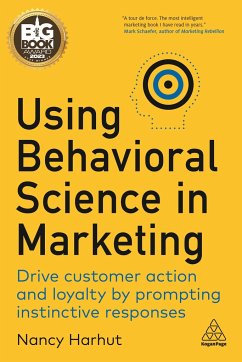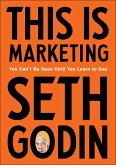Nancy Harhut
Using Behavioral Science in Marketing
Drive Customer Action and Loyalty by Prompting Instinctive Responses
Nancy Harhut
Using Behavioral Science in Marketing
Drive Customer Action and Loyalty by Prompting Instinctive Responses
- Broschiertes Buch
- Merkliste
- Auf die Merkliste
- Bewerten Bewerten
- Teilen
- Produkt teilen
- Produkterinnerung
- Produkterinnerung
Apply behavioral science techniques in key areas of marketing to drive consumer action for increased engagement and conversion rates.
Andere Kunden interessierten sich auch für
![Human-Centered Marketing Human-Centered Marketing]() Ashley FausHuman-Centered Marketing26,99 €
Ashley FausHuman-Centered Marketing26,99 €![B2B Customer Experience B2B Customer Experience]() Paul HagueB2B Customer Experience26,99 €
Paul HagueB2B Customer Experience26,99 €![This Is Marketing This Is Marketing]() Seth GodinThis Is Marketing20,99 €
Seth GodinThis Is Marketing20,99 €![Martech Handbook Martech Handbook]() Darrell AlfonsoMartech Handbook39,99 €
Darrell AlfonsoMartech Handbook39,99 €![Influencing Shopper Decisions Influencing Shopper Decisions]() Rebecca BrooksInfluencing Shopper Decisions35,99 €
Rebecca BrooksInfluencing Shopper Decisions35,99 €![Competing Against Luck Competing Against Luck]() Clayton M. ChristensenCompeting Against Luck20,99 €
Clayton M. ChristensenCompeting Against Luck20,99 €![Jab, Jab, Jab, Right Hook Jab, Jab, Jab, Right Hook]() Gary VaynerchukJab, Jab, Jab, Right Hook19,99 €
Gary VaynerchukJab, Jab, Jab, Right Hook19,99 €-
-
-
Apply behavioral science techniques in key areas of marketing to drive consumer action for increased engagement and conversion rates.
Produktdetails
- Produktdetails
- Verlag: Kogan Page
- Artikelnr. des Verlages: 13892
- Seitenzahl: 288
- Erscheinungstermin: August 2022
- Englisch
- Abmessung: 234mm x 156mm x 19mm
- Gewicht: 440g
- ISBN-13: 9781398606487
- ISBN-10: 1398606480
- Artikelnr.: 63208230
- Herstellerkennzeichnung
- Libri GmbH
- Europaallee 1
- 36244 Bad Hersfeld
- gpsr@libri.de
- Verlag: Kogan Page
- Artikelnr. des Verlages: 13892
- Seitenzahl: 288
- Erscheinungstermin: August 2022
- Englisch
- Abmessung: 234mm x 156mm x 19mm
- Gewicht: 440g
- ISBN-13: 9781398606487
- ISBN-10: 1398606480
- Artikelnr.: 63208230
- Herstellerkennzeichnung
- Libri GmbH
- Europaallee 1
- 36244 Bad Hersfeld
- gpsr@libri.de
Nancy Harhut
- Chapter - 01: Emotional and rational elements in decision making;
- Chapter - 02: Conveying customer benefits through loss aversion and the endowment effect;
- Chapter - 03: Achieving urgency and exclusivity through the scarcity principle;
- Chapter - 04: The reciprocity principle and the marketing value of give to get;
- Chapter - 05: Social proof - Harnessing the power of people like us, and the people we like;
- Chapter - 06: Storytelling - Increasing consumer involvement and engagement;
- Chapter - 07: Autonomy bias - Harnessing the human need for control;
- Chapter - 08: Encouraging sales and loyalty through the consistency principle and the Zeigarnik effect;
- Chapter - 09: Information gap theory - Prompting consumers to take action through curiosity and the need to know;
- Chapter - 10: Tapping into the authority principle to stand out and prompt responses;
- Chapter - 11: Choice architecture and status quo bias - How to use inertia to get things moving;
- Chapter - 12: Labeling and framing - Making people see things your way;
- Chapter - 13: Increasing action through automatic compliance triggers and reasons;
- Chapter - 14: Maximizing the impact of your marketing copy and language;
- Chapter - 15: Increasing desirability though triggering availability bias;
- Chapter - 16: Creating stand out marketing communications through context, rewards and unpredictability;
- Chapter - 17: Temporal discounting and temporal landmarks - The effects of time on behavior
Chapter
01: Emotional and rational elements in decision making; Chapter
02: Conveying customer benefits through loss aversion and the endowment effect; Chapter
03: Achieving urgency and exclusivity through the scarcity principle; Chapter
04: The reciprocity principle and the marketing value of give to get; Chapter
05: Social proof
Harnessing the power of people like us, and the people we like; Chapter
06: Storytelling
Increasing consumer involvement and engagement; Chapter
07: Autonomy bias
Harnessing the human need for control; Chapter
08: Encouraging sales and loyalty through the consistency principle and the Zeigarnik effect; Chapter
09: Information gap theory
Prompting consumers to take action through curiosity and the need to know; Chapter
10: Tapping into the authority principle to stand out and prompt responses; Chapter
11: Choice architecture and status quo bias
How to use inertia to get things moving; Chapter
12: Labeling and framing
Making people see things your way; Chapter
13: Increasing action through automatic compliance triggers and reasons; Chapter
14: Maximizing the impact of your marketing copy and language; Chapter
15: Increasing desirability though triggering availability bias; Chapter
16: Creating stand out marketing communications through context, rewards and unpredictability; Chapter
17: Temporal discounting and temporal landmarks
The effects of time on behavior
01: Emotional and rational elements in decision making; Chapter
02: Conveying customer benefits through loss aversion and the endowment effect; Chapter
03: Achieving urgency and exclusivity through the scarcity principle; Chapter
04: The reciprocity principle and the marketing value of give to get; Chapter
05: Social proof
Harnessing the power of people like us, and the people we like; Chapter
06: Storytelling
Increasing consumer involvement and engagement; Chapter
07: Autonomy bias
Harnessing the human need for control; Chapter
08: Encouraging sales and loyalty through the consistency principle and the Zeigarnik effect; Chapter
09: Information gap theory
Prompting consumers to take action through curiosity and the need to know; Chapter
10: Tapping into the authority principle to stand out and prompt responses; Chapter
11: Choice architecture and status quo bias
How to use inertia to get things moving; Chapter
12: Labeling and framing
Making people see things your way; Chapter
13: Increasing action through automatic compliance triggers and reasons; Chapter
14: Maximizing the impact of your marketing copy and language; Chapter
15: Increasing desirability though triggering availability bias; Chapter
16: Creating stand out marketing communications through context, rewards and unpredictability; Chapter
17: Temporal discounting and temporal landmarks
The effects of time on behavior
- Chapter - 01: Emotional and rational elements in decision making;
- Chapter - 02: Conveying customer benefits through loss aversion and the endowment effect;
- Chapter - 03: Achieving urgency and exclusivity through the scarcity principle;
- Chapter - 04: The reciprocity principle and the marketing value of give to get;
- Chapter - 05: Social proof - Harnessing the power of people like us, and the people we like;
- Chapter - 06: Storytelling - Increasing consumer involvement and engagement;
- Chapter - 07: Autonomy bias - Harnessing the human need for control;
- Chapter - 08: Encouraging sales and loyalty through the consistency principle and the Zeigarnik effect;
- Chapter - 09: Information gap theory - Prompting consumers to take action through curiosity and the need to know;
- Chapter - 10: Tapping into the authority principle to stand out and prompt responses;
- Chapter - 11: Choice architecture and status quo bias - How to use inertia to get things moving;
- Chapter - 12: Labeling and framing - Making people see things your way;
- Chapter - 13: Increasing action through automatic compliance triggers and reasons;
- Chapter - 14: Maximizing the impact of your marketing copy and language;
- Chapter - 15: Increasing desirability though triggering availability bias;
- Chapter - 16: Creating stand out marketing communications through context, rewards and unpredictability;
- Chapter - 17: Temporal discounting and temporal landmarks - The effects of time on behavior
Chapter
01: Emotional and rational elements in decision making; Chapter
02: Conveying customer benefits through loss aversion and the endowment effect; Chapter
03: Achieving urgency and exclusivity through the scarcity principle; Chapter
04: The reciprocity principle and the marketing value of give to get; Chapter
05: Social proof
Harnessing the power of people like us, and the people we like; Chapter
06: Storytelling
Increasing consumer involvement and engagement; Chapter
07: Autonomy bias
Harnessing the human need for control; Chapter
08: Encouraging sales and loyalty through the consistency principle and the Zeigarnik effect; Chapter
09: Information gap theory
Prompting consumers to take action through curiosity and the need to know; Chapter
10: Tapping into the authority principle to stand out and prompt responses; Chapter
11: Choice architecture and status quo bias
How to use inertia to get things moving; Chapter
12: Labeling and framing
Making people see things your way; Chapter
13: Increasing action through automatic compliance triggers and reasons; Chapter
14: Maximizing the impact of your marketing copy and language; Chapter
15: Increasing desirability though triggering availability bias; Chapter
16: Creating stand out marketing communications through context, rewards and unpredictability; Chapter
17: Temporal discounting and temporal landmarks
The effects of time on behavior
01: Emotional and rational elements in decision making; Chapter
02: Conveying customer benefits through loss aversion and the endowment effect; Chapter
03: Achieving urgency and exclusivity through the scarcity principle; Chapter
04: The reciprocity principle and the marketing value of give to get; Chapter
05: Social proof
Harnessing the power of people like us, and the people we like; Chapter
06: Storytelling
Increasing consumer involvement and engagement; Chapter
07: Autonomy bias
Harnessing the human need for control; Chapter
08: Encouraging sales and loyalty through the consistency principle and the Zeigarnik effect; Chapter
09: Information gap theory
Prompting consumers to take action through curiosity and the need to know; Chapter
10: Tapping into the authority principle to stand out and prompt responses; Chapter
11: Choice architecture and status quo bias
How to use inertia to get things moving; Chapter
12: Labeling and framing
Making people see things your way; Chapter
13: Increasing action through automatic compliance triggers and reasons; Chapter
14: Maximizing the impact of your marketing copy and language; Chapter
15: Increasing desirability though triggering availability bias; Chapter
16: Creating stand out marketing communications through context, rewards and unpredictability; Chapter
17: Temporal discounting and temporal landmarks
The effects of time on behavior








